Versoix
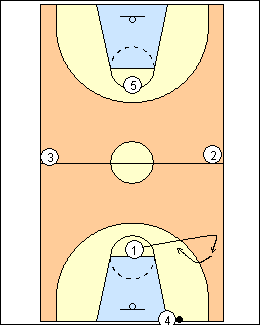 | 1 This press break flows out of the fast break. 5 goes upcourt and stays opposite the ball (Bill Self). Get the ball out and in fast. 4 gets the ball out of the net quickly (before it bounces), runs out of bounds on the right side with two hands on the ball, uses pass fakes, runs the baseline so that the pass is vertical not diagonal, does not follow the pass, he creates an easy passing angle (Coach K), then stays behind the ball until it crosses centre. The point guard gets his butt to the ballside sideline with an inside turn, if he doesn't get the ball he circles back on the run (Roy Williams, Bruce Pearl). Tom Izzo - go to the side of the inbounder's strong hand, the outlet spot is foul-line extended one yard from the sideline, the inbounder leads the point guard upcourt if possible. If the point guard is overplayed, his first step is towards the ball, his second step is on a diagonal towards the middle. coachesclipboard.ca - 1 creates space with a misdirect cut then shows his hands on a circle cut back to the ball (for a control pass) or a back cut away from the ball (an attack pass). If a defender shows chest, 1 takes a couple of hard steps into him then back cuts; if the defender shows fingertips/forearm, 1 takes a couple of hard steps into him then face cuts to get in front - swim over a low arm, rip underneath a high arm. If the defender takes away the step-over, spin back the opposite direction. 1 has a little more time after a make to get wide then break back to the middle. Mike MacKay - 1 runs a tight circle cut. Bill Self - if 4 is right-handed, start on the left side, better to run the baseline, and better defenders are usually on the right. Roy Williams - 4 doesn't go out the same side all the time. Coach K - 2 and 3 come back into the backcourt, 5 goes to about halfcourt until the inbounds pass is made, then goes upcourt. Blaine Taylor - leading late in the game, use 1 as trigger except on spot inbounds, he can run the baseline, get it in, and get it back. Tom Crean - put your best driver on the weakside, he will most likely be matched up against the slowest press defender (excluding X5), and the weakside provides the most driving opportunities against a press. |
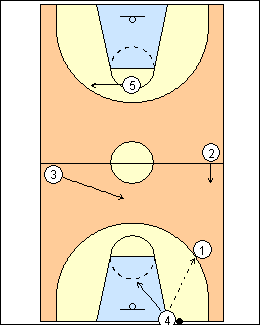 | 2 A ballhandler should have a long pass option and three short pass options: a player ballside, middle, and back when the ball is on the side, and on each side and in the middle when the ball is in the middle. 3 cuts to provide a short-middle option for 1, 2 is ballside sideline. coachesclipboard.ca - always have someone side, middle and back when the ball is on the side, and on each side and in the middle when the ball is in the middle of the court. Duke - there should always be three short options and one long option. John Brady - it is better for 2 and 3 to be closer to the ball (12-15 feet) than farther away. Dave Odom - 4 comes in ballside, 2 must break the line of the defence at halfcourt, he can't be backside. Attack pressure where it is applied or it will keep coming after you. |
 | 3 On ball reversal to trailer 4, 3 cuts to be a sideline option, 2 goes short middle (see Duke vs 1-2-1-1). Dave Odom - 1 slices up the middle, 2 comes behind to take 1's spot (they always want to throw middle then look long, slice to the middle any time you reverse the ball). Avery Johnson - if 1 is double-teamed and X3 rotates up to cover 4, 4 moves back to stretch the rotation, 3 finds an open area if 2 and 4 are denied. |
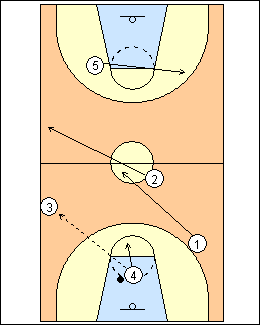 | 4 On a pass to 3, 2 goes ballside sideline, 1 goes short middle, 4 moves up but staying behind the ball. Option - to always have someone behind the ball, 4 dribbles towards 3, who moves up the sideline, and 1 moves behind 4 as safety. John Brady (LSU Set) - 4 takes two dribbles upcourt towards the sideline, 1 slides behind the ball (always have someone behind the ball). Old Dominion trap "O" - when 4 dribbles towards the left, 3 swivels up the sideline, 1 swivels back as safety, 5 goes to the other side. Dave Odom - a good rule in basketball is leave an area, fill an area. The first slice guy takes defence with him, the second guy coming in behind is the one you probably want to hit. |
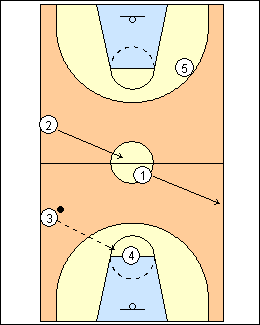 | 5 With an 8-second backcourt count there is usually time for only one ball reversal, but here is the pattern if the ball is reversed again to 4. |
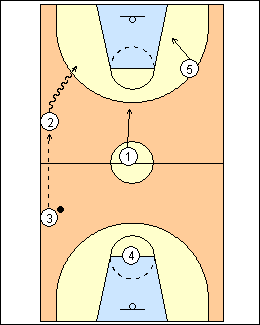 | 6 If 3 passes ahead to 2, look to attack on the dribble. Bill Self - 2 tries to get the ball to the middle. If 2 gets the ball in the backcourt, 1 cuts up the ballside sideline to continue the press break, 3 cuts short middle (see Double-middle press break). |
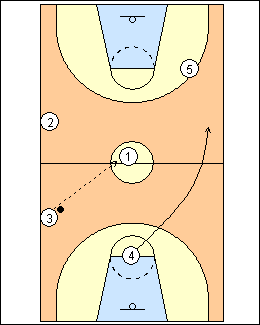 | 7 Bill Self - on a pass to the middle, the trailer runs wide opposite, the passer becomes the new trailer. breakthroughbasketball.com - once you get the ball in the middle, the press will be beaten 99% of the time. |
 | 8 If 1 is not open on a circle cut or backcut, 2 breaks to the ball, 1 cuts up the middle, then breaks to the ballside sideline on the inbounds pass. If 1 is in the passing lane to 2, 4 runs the baseline (see Arizona) or optionally 2 comes back to the middle (Canada Basketball, Falcon, Lakers press breaks). coachesclipboard.ca - if 1 can't get the ball he cuts up the middle while 2 breaks hard back to the ball for a pass, and looks to pass quickly to 1 on a contact cut. Larry Brown - the point guard takes off when pressed, don't wait for the inbounds pass. Rick Majerus - always look to bypass with the wings. Bill Self - against a "hot" press you don't want to inbounds to 1, he is a decoy. Double-middle press break - the pass to 2 is preferred if the press looks to trap the first pass. Variations if 1 is double-teamed - he walks the two defenders to the baseline, unguarded 4 cuts for a return pass after inbounding to 2 (coachesclipboard.net) - he steps behind the baseline for a pass and makes a quick return pass to 4 cutting upcourt (see Versoix press-break specials). |
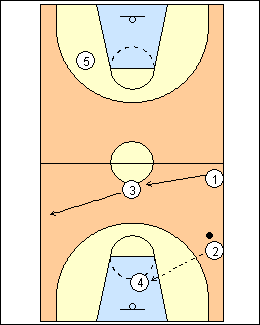 | 9 On ball reversal to 4, 3 breaks back to the sideline, 1 shows short middle. |
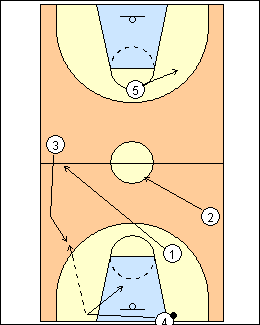 | 10 The same system on an inbounds pass to 3 (4 can run the baseline after a made free throw or field goal). Bill Self - 3 flashes back and angles in to cut off his defender. Arizona - if 1 cuts ballside and is covered, he takes away 2's lane so 4 runs the baseline, and then the passing angle to 1 cutting up the middle is better. 3 comes back hard, v-cutting into his defender's path then back out towards the sideline. |
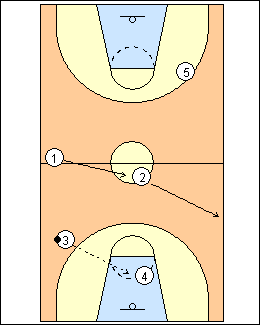 | 11 Reversal to the trailer. |
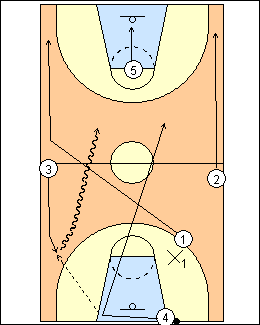 | 12 Against a press that denies the inbounds pass to 1 but does not trap (or effectively trap) on the inbounds pass, optionally stay on attack in the flow of the offence. Here on the inbounds pass to 3, 1 crosses the floor to fill 3's spot, 2 goes up the far sideline (instead of coming short middle), 4 trails. 1 and 3 flip-flop roles, 3 is now the point guard, and pushes the ball with all the same options but attacking on the left side of the floor. See the 5star press break. |
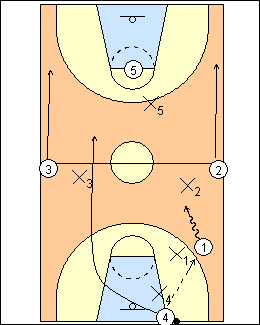 | 13 Options using 4 a) Clear-out 4 inbounds then clears opposite so his man can't help on the ball, usually against a man-to-man press that does not trap on the inbounds pass. Gary Williams - most teams will clear out against fullcourt man pressure. Billy Tubbs - if you don't trap the inbounds pass they will clear out, and the man press doesn't work. See Arizona, Dave Odom press breaks. |
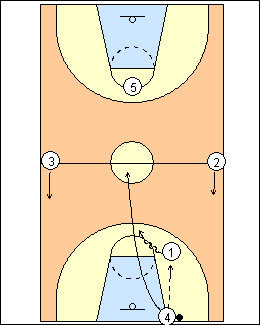 | 14 b) Go middle Against a press that does not trap on the inbounds pass (e.g., a 2-2-1), 4 can inbounds then sprint to the centre circle, the receiver is the trailer, run the system from there. Get the ball to the middle, swivel if the ballhandler dribbles towards a sideline. See Duke vs 2-2-1, Old Dominion trap "O", Arizona, 5star. Dave Odom - against a 2-2-1, you must take the ball to the level of the defence. |
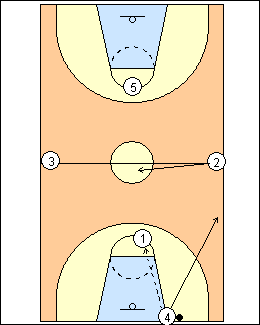 | 15 c) Sideline support Usually look to attack if a ballhandler gets the ball in the middle of the floor. If 4 inbounds to 1 in the middle, 1 looks to score, he has 2 and 3 on each side ahead of the ball, 4 trails the play, there are three short receivers (see Canada Basketball). However, there is no short middle receiver, so optionally 4 goes up the near sideline, pushing 2 to the middle (shown), 1 is the trailer (see Bill Self, Falcon). Another option is that 5 comes back to the ball in the short middle, 2 stays on the sideline, 4 steps in as the trailer. |
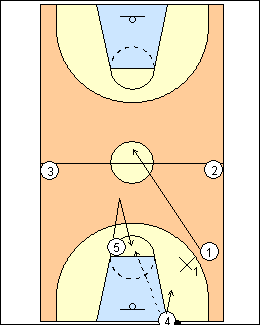 | 16 Options using 5 a) Double back 5 doubles back if 1 is denied, 1 cuts up the middle on a pass to 5 (see Hoop Tactics, Gregg Popovich, Larry Brown, Roy Williams). 5 goes upcourt opposite the ball if he does not get the inbounds pass. Roy Williams - 5 is an emergency outlet. He runs up the middle of the floor, at the top of the arc he turns to see if 1 is denied, if so he comes towards the ball. On a pass to 5, 1 sprints upcourt. breakthroughbasketball.com - if you have a really tall player on your team you can position them close to the inbounder and throw a high inbounds pass where no one else can get it, the big jumps to catch the ball high. |
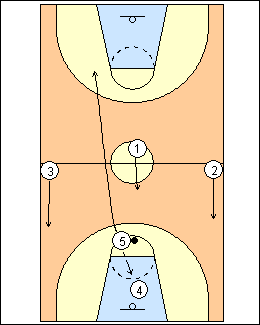 | 17 If 5 passes back to 4 he goes long, 1, 2 and 3 come back towards the ball. |
 | 18 b) Screen for 1 1 starts at the top of the key, 5 is in front of and facing the ball, he drop steps and screens with his back to the ballside corner (Bill Self), 1 and 5 go opposite. 1 cuts up the middle on a pass to 5 (coachesclipboard.ca). 5 again goes upcourt if he does not get the inbounds pass, or if he gets it and passes back to 4. Arizona - if the press is looking to deny or trap the inbounds pass, 5 sets a straight-on screen below the middle of the foul line, 1 can go either way, if he comes ballside and isn't open, 4 runs the baseline. 5 is gone as soon as the ball is inbounded. On a spot inbounds, 1 cuts weakside, 5 comes to the ball, they can usually get it to him if stuck. Hubie Brown - 5 is at the top marker facing the ball, 1 walks his defender into 5, grabs 5's waist and breaks to the corner (over or under 5). |
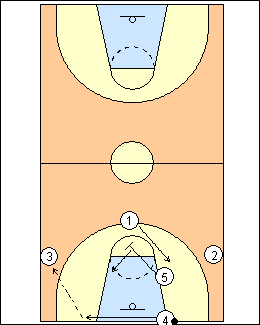 | 19 1-4 variation Bring 2 and 3 back into a 1-4 set to provide passing options, although it crowds the backcourt. Against a 1-2-1-1, hit the wings, 4 should be able to run the baseline and pass to 3 or 2. 5 again clears out if he does not get the inbounds pass. breakthroughbasketball.com - against a zone press that pressures the inbounds passer, you should easily be able to inbounds the ball to the outside receivers. Against a man-to-man press that is denying the inbounds pass, you want them to break upcourt. The other two receivers screen for each other. Blaine Taylor - against a 1-2-1-1 it is usually easy to inbounds by running the baseline and passing to outside players (see Old Dominion line). If the press brings up five players, look for an attacker to break long, see Versoix specials. |
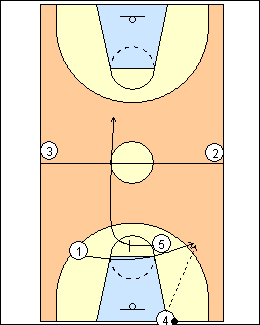 | 20 Avery Johnson After a made basket, usually X5 gets back to cover the basket as safety, so they try to get 5 in position to set a screen for 1 (similar to a brush screen), 1 then makes a banana cut to get the ball and 5 heads upcourt. Basketball New South Wales - 5 screens at the weakside elbow for 1 then sprints upcourt and seals. |
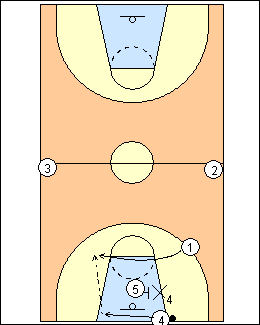 | 21 c) Brush screen X4 4 may need to run the baseline to changes sides (Avery Johnson). |
This page was made with Basketball playbook from Jes-Soft